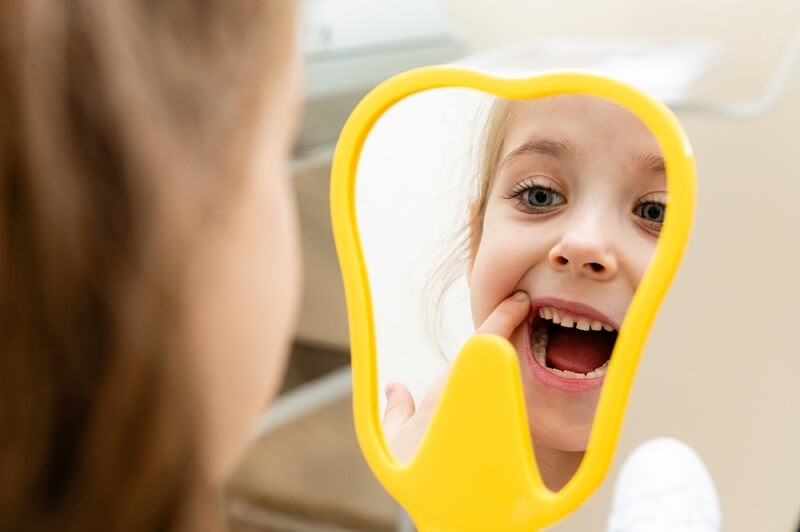
As a parent, it's extraordinary to watch your little one grow. All those heartwarming moments - the first giggle, the first steps, and yes, the first tooth! Baby teeth may be small, but they play an essential role in children's early development, including aiding in speech formation and instilling healthy eating habits...the list goes on! Our 2025 Baby Teeth Guide: Eruption, Care & Milestones has everything you'll need, including a complete baby teeth chart, information on teething symptoms, baby teeth care guidelines, and your child's unique baby teeth eruption timelines.
Whether you're a first-time parent or are just looking for a little refresher, this blog explains each of the critical moments in your baby's teething process, with guidance to confidently navigate the exciting (and often drooly) path ahead.
Your baby's primary teeth, or baby teeth, are the first set of teeth your infant will develop. There are 20 baby teeth: 10 on top and 10 at the bottom. Baby teeth help children eat solid foods, but they also have other vital functions, such as
Even though they are temporary, taking care of baby teeth is vital since poor oral hygiene habits at a young age lead to cavities, pain, and later orthodontic treatment.
Related Resource: Baby Dental Care: Guide to the First Dentist Appointment
The timing for baby teeth eruption varies slightly from child to child, but babies generally start teething between 4 and 7 months. Below is a general schedule for baby teeth eruption:
| Tooth Type | Eruption Age (Months) | Shedding Age (Years) |
| Central Incisors (Bottom) | 6–10 months | 6–7 years |
| Central Incisors (Top) | 8–12 months | 6–7 years |
| Lateral Incisors | 9–16 months | 7–8 years |
| First Molars | 13–19 months | 9–11 years |
| Canines (Cuspids) | 16–23 months | 9–12 years |
| Second Molars | 23–33 months | 10–12 years |
Pro Tip: Don’t panic if your baby’s teeth don’t follow this exact schedule. Genetics and other factors can influence eruption timing.
Teething can be a challenging time for babies and parents. Each child is different, but here are the most recognized baby teething symptoms:
Myth Buster: Teething does not produce a high fever or diarrhea. A pediatrician must be consulted if a child has a high fever or diarrhea.
Managing your child’s teething discomfort is about soothing and keeping the gums as calm as possible. Here are proven methods:
Use BPA-free teething rings or silicone toys. Chilling them in the fridge can offer extra relief.
Wash your hands and gently rub your baby’s gums with your finger.
Let your baby chew on a clean, damp cloth that’s been chilled.
Nursing provides both comfort and distraction during painful moments.
Ideal for older babies (8+ months), these are safe to gnaw on and provide relief.
A baby teeth chart is a great visual tool to monitor your baby’s dental development. Below is a simplified version to print or pin:
- Central Incisor: 8–12 months
- Lateral Incisor: 9–13 months
- Canine (Cuspid): 16–22 months
- First Molar: 13–19 months
- Second Molar: 25–33 months
- Central Incisor: 6–10 months
- Lateral Incisor: 10–16 months
- Canine (Cuspid): 17–23 months
- First Molar: 14–18 months
- Second Molar: 23–31 months
Tracking your baby's progress helps ensure no abnormalities or delays need professional attention.

Baby teeth care starts before the first tooth even erupts! Early on, developing a dental hygiene routine sets the foundation for a healthy smile.
Here are some key baby teeth milestones to watch for and celebrate:
Capture that first toothy grin—it’s a significant milestone!
Your child should have 20 baby teeth by their third birthday.
Introduce your child to dental care early. Pediatric dentists are trained to make it fun and stress-free.
With supervision, kids can begin learning how to brush on their own.
A new chapter begins as baby teeth make way for adult ones.
A: Late eruption is usually normal, especially if it runs in the family. Check in with your pediatric dentist if no teeth appear by 18 months.
A: This happens when adult teeth erupt behind baby teeth before they fall out. It often resolves naturally, but a dentist might recommend extraction.
A: Absolutely. Cavities in baby teeth can lead to pain, infection, and problems with permanent teeth. Early dental care is key.
A balanced diet helps build strong teeth and gums. These foods are particularly tooth-friendly:
Avoid sugary snacks and juices, which contribute to early tooth decay.
Here are some parent-approved tools to help with baby teething in 2025:
Always read the safety guidelines and consult your pediatrician before using new products.
Suggested Read: Tooth Pain? Here's What to Do in a Dental Emergency
Teething can appear overwhelming; however, with knowledge and the right tools, it can be a manageable (and exciting) stage of parenting. By knowing the baby teeth eruption timeline, identifying teething symptoms, practicing good baby teeth care, and using a baby teeth chart to track progress, you are simply putting your child in an excellent place for a lifetime of good oral health. Celebrate those small milestones—each tooth is a mini-victory!
Lastly, if anything ever seems out of the ordinary, or you want reassurance, your pediatric dentist can be a great partner!
This content was created by AI